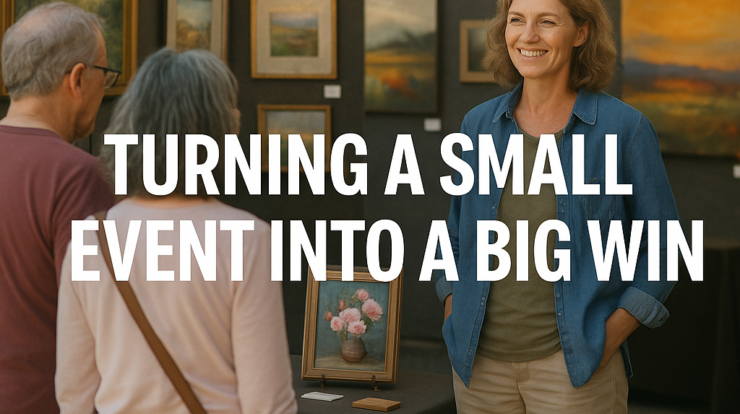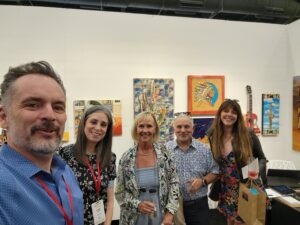
Making the Most of Modest Shows, Light Traffic, and Off-the-Path Booths
Not every art festival or studio tour draws huge crowds. You may be placed in a quiet corner, or your booth might get less foot traffic than others. Maybe the event is new, under-promoted, or competing with five others in the same weekend.
Whatever the reason, light turnout happens. But that doesn’t mean the show is a loss. Some of the most valuable connections—and strongest sales—come from events that feel slow on the surface. With the right mindset and approach, even a quiet festival or studio tour can become a turning point.
Here’s how to make sure your time and effort still pay off.
1. Redefine What “Success” Looks Like
If your only goal is to sell a certain number of pieces on the spot, small events will often disappoint. But if you see success more broadly—conversations, future leads, exposure, networking—you’ll discover more reasons to feel good at the end of the day.
Ask yourself:
-
Did you meet anyone genuinely interested in your work?
-
Did you have conversations that helped you better understand how people connect with your art?
-
Did you make contact with a gallery, event organizer, or fellow artist?
-
Did you gain insight into how to improve your setup or pricing?
Not all rewards show up in your square reader.
2. Make Your Booth or Studio Space Work Harder
You don’t need a huge footprint to make a big impression. Especially when the crowds are thin, your presentation can do a lot of the heavy lifting:
-
Use lighting strategically. Good lighting draws people in—even in daylight or outdoor spaces.
-
Create a clear focal point. One standout piece can catch someone’s eye across the venue.
-
Display a range of price points. A high-end piece may draw attention, but smaller works or prints can make buying easier.
-
Add short, compelling signage. Include prices, titles, and one-liners that give people something to respond to.
In one show I heard about, an artist was placed far from the main action—but asked organizers if snacks could be stationed near her space. They agreed, and suddenly traffic flowed her way. Simple adjustments can make a big difference.
3. Be Approachable and Engaged
When traffic is light, the artists who stay present, standing, and welcoming are often the ones who come out ahead.
-
Start with a question: “Are you visiting other studios today?” or “What kind of work do you enjoy collecting?”
-
Tell short stories about your pieces. Think opening-night energy, even if it’s hour four.
-
Repeat your key messages. They may feel rehearsed to you, but they’re new to each visitor.
-
Invite connection. Offer your card, QR code, or newsletter signup—even if the person isn’t ready to buy.
A few strong conversations can plant seeds that lead to sales after the event.

4. Capture the Wisdom, Not Just the Sales
After the show, don’t just count your receipts. Write down what you observed:
-
What display elements drew the most attention?
-
Which pieces got the most comments?
-
Who seemed most engaged—and did you get their contact info?
-
What would you do differently next time?
This is where real progress happens—between shows, not just during them.
5. Follow Up and Follow Through
Your work at a festival or studio tour doesn’t end when you take down your booth. Keep the momentum going:
-
Post photos from your setup and thank people for stopping by
-
Email new contacts (with permission) and thank them personally
-
Mention your next show, collection release, or gallery appearance
-
Reach out to any organizers, artists, or connections you want to deepen
Even one follow-up message can lead to a future opportunity or sale.
Final Thought
Small shows aren’t wasted time—they’re training ground. They help you refine your pitch, test your setup, and connect with real people. And sometimes, when it’s quiet and you least expect it, the right person walks in and everything clicks.
So whether you’re prepping for a major art fair or a small neighborhood studio tour, show up like it matters. Because it does.
This is great info! I have an upcoming studio tour – not in my studio but sharing space with 2 other artists in Sept., great info! I just got approved and some planning has already begun but you mentioned some areas I haven’t thought about. Thank you! I always appreciate your comments and advice.
Jason – the timing of this is perfect and comes right after a festival where I didn’t sell anything. But I didn’t let it get to me. Sure, I would’ve preferred to have some money coming in, but I took the time to evaluate the pieces I brought and my pricing to see where I could add more value at the next event. I focused on the people I spoke with and know that there could be a future sale from those conversations. In the past, I would’ve been distraught, but time and wisdom has lead me to think about all the things you mention here. Thanks for the confirmation and reminder.
I count getting names on my mailing list as gold – it allows me to stay in contact and increase my connection with visitors by sharing my painting stories. Once we know someone better we are more likely to buy something from them or take a class from them. We are playing the long game here! ; )
I approach shows a bit differently. I make art for me. I cannot not make art, so I make it and I show at art shows to initiate conversations with people about what I do and what they see in my work. Don’t get me wrong; I sell, and my average sale price is $3,000. But it’s like the movie line; “ if you build it they will come”. Exhibiting gives me an understanding of my work through other peoples eyes, and the feedback I receive is valuable for gauging how I’m doing towards reaching people. I likely won’t change what I do but the affirmation and validation I receive through conversations is worth the price of admission.
thank you Jason your post was so true. People respond when you welcome them and introduce yourself. I always give out my business card and it works over the last few years. i am well known which has surprised me. Thanks Rick Hamilton
👍👍👍